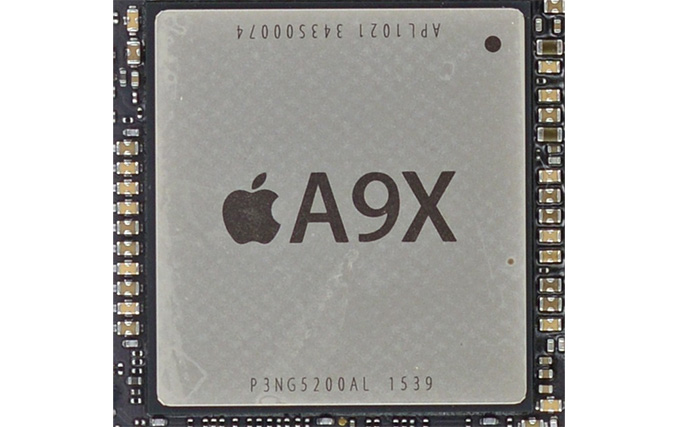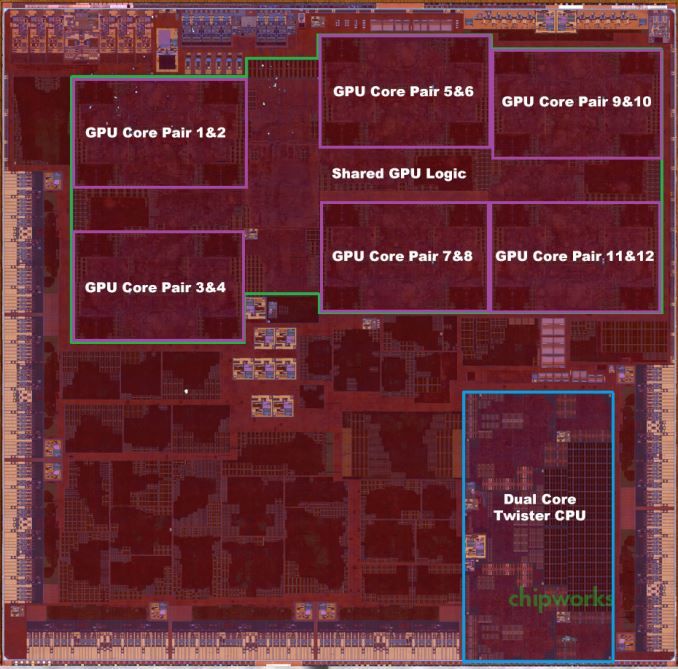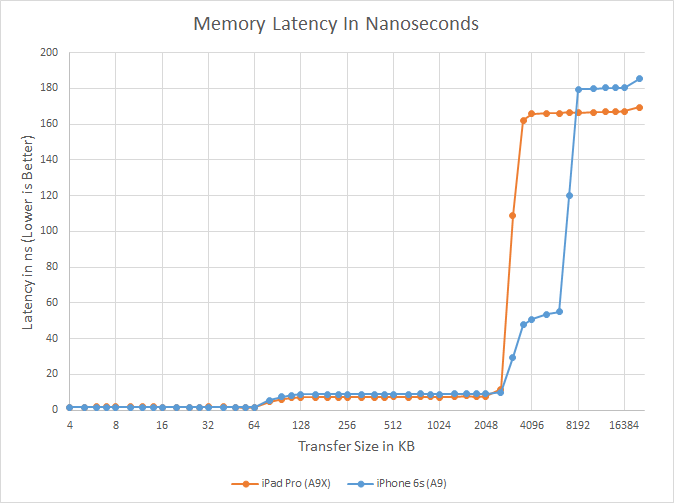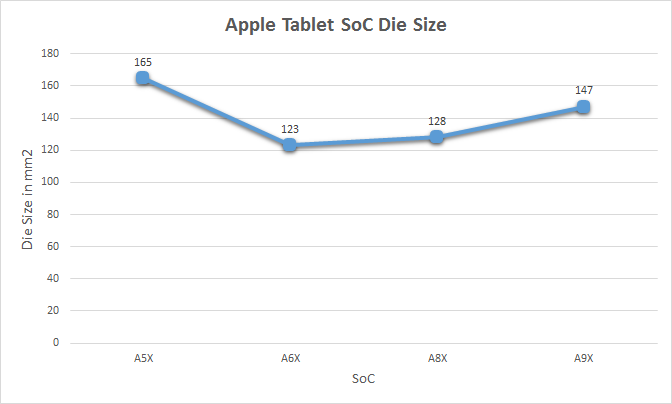The Apple iPad Pro Review
by Ryan Smith, Joshua Ho & Brandon Chester on January 22, 2016 8:10 AM ESTSoC Analysis: Apple A9X
Diving into the heart of the iPad Pro, we have Apple’s latest generation tablet SoC, A9X. Like the other Apple X series SoCs before it, A9X is by and large an enhanced and physically larger version of Apple’s latest phone SoC, taking advantage of the greater space and heat dissipation afforded by a tablet to produce a more powerful SoC.

Apple's A9X (Image Courtesy iFixit)
That Apple has developed a new SoC to launch alongside the iPad Pro is in no way surprising, but just as how the iPad Pro has ramifications for the overall iPad lineup as Apple gets into the productivity tablet market, iPad Pro’s genesis is reflected in its component selection. Apple already needed a powerful SoC for the iPad Air 2 in order to keep performance up with the tablet’s high resolution of the screen, and iPad Pro in turn pushes Apple’s performance needs even harder. Not only is there an even higher resolution screen to drive – the 2732x2048 display has about 66% of the pixels of a 4K display – but now Apple needs to deliver suitable performance for content creation and meaningful multitasking. I don’t want to imply that the A9X was somehow specifically designed from scratch for the iPad Pro, as there are a number of more important engineering considerations, but I do want to highlight how the iPad Pro is not just another iPad, and that as Apple expands the capabilities of the iPad they need to expand the performance as well if they wish to extend their reputation for smooth UX performance.
Looking at the specifications of the A9X, it seems like Apple always throws us a curveball on the X series SoCs, and for their latest SoC this is no different. With A8X Apple delivered more RAM on a wider memory bus, a larger GPU, and surprisingly, three Typhoon CPU cores. To date it’s still not clear just why Apple went with three CPU cores on A8X – was it for multitasking, or as an alternative means to boost performance – and A9X’s configuration only serves to highlight this enigma.
| Apple SoC Comparison | ||||||
| A9X | A9 | A8X | A6X | |||
| CPU | 2x Twister | 2x Twister | 3x Typhoon | 2x Swift | ||
| CPU Clockspeed | 2.26GHz | 1.85GHz | 1.5GHz | 1.3GHz | ||
| GPU | PVR 12 Cluster Series7XT | PVR 6 Cluster Series7 (PVR GT7600) |
PVR 8 Cluster Series6XT (APL GXA6850) |
PVR SGX554 MP4 | ||
| RAM | 4GB LPDDR4 | 2GB LPDDR4 | 2GB LPDDR3 | 1GB LPDDR2 | ||
| Memory Bus Width | 128-bit | 64-bit | 128-bit | 128-bit | ||
| Memory Bandwidth | 51.2GB/sec | 25.6GB/sec | 25.6GB/sec | 17.1GB/sec | ||
| L2 Cache | 3MB | 3MB | 2MB | 1MB | ||
| L3 Cache | None | 4MB | 4MB | N/A | ||
| Manufacturing Process | TSMC 16nm FinFET | TSMC 16nm & Samsung 14nm |
TSMC 20nm | Samsung 32nm | ||
Instead of continuing with a triple-core CPU design for A9X, for their latest X series SoC Apple has dropped back down to just a pair of Twister CPU cores. The catch here – and why two cores is in many ways better than three – is that relative to A8X and A9, Apple has cranked up their CPU clockspeeds. Way, way up. Whereas the iPad Air 2 (A8X) shipped at 1.5GHz and the iPhone 6s (A9) at 1.85GHz, the A9X sees Apple push their clockspeed to 2.26GHz. Not counting the architectural changes, this is 22% higher clocked than the A9 and 51% higher than the A8X.
The fact that Apple dropped back down to 2 CPU cores is unexpected given that we don’t expect Apple to ever go backwards in such a fashion, and while we’ll never know the official reason for everything Apple does, in retrospect I’m starting to think that A8X was an anomaly and Apple didn’t really want a tri-core CPU in the first place. A8X came at a time where Apple was bound by TSMC’s 20nm process and couldn’t drive up their clockspeeds without vastly increasing power consumption, so a third core was a far more power effective option.

A9X Die Shot w/AT Annotations (Die Shot Courtesy Chipworks)
Overall this means that iPad Pro and A9X will set a very high bar for tablet CPU performance. As we’ve already seen in the iPhone 6s review, the Twister CPU core is very potent and in most cases faster than any other ARM CPU core by leaps and bounds. Cranking up the clockspeed a further 22% only serves to open up that gap even further, as Twister is now reaching clockspeeds similar to the likes of Cortex-A57 and A72, but with its much wider execution pipeline and greater IPC. This is also the reason that an Intel Core CPU comparison is so interesting, as Intel’s tablet-class Core processors in many ways are the target to beat on overall CPU performance, and we’ll be touching upon this subject in greater detail a bit later.
GPU: Imagination PowerVR 12 Cluster Series 7XT
Meanwhile on the GPU side, as expected Apple has further increased the number of clusters on their SoC to drive the higher resolution display of a tablet. Whereas A9 used a 6 cluster design (PVR GT7600), A9X doubles this, giving us a relatively massive 12 cluster design.
In Imagination’s PowerVR Series7XT roadmap, the company doesn’t have an official name for a 12 cluster configuration, as this falls between the 8 cluster GT7800 and 16 cluster GT7900. So for the moment I’m simply calling it a “PowerVR 12 cluster Series7XT design,” and with any luck Imagination will use a more fine-grained naming scheme for future generations of PowerVR graphics.
In any case, the use of a 12 cluster design is a bit surprising from an engineering standpoint since it means that Apple was willing to take the die space hit to implement additional GPU clusters, despite the impact this would have on chip yields and costs. If anything, with the larger thermal capacity and battery of the iPad Pro, I had expected Apple to use higher GPU clockspeeds (and eat the power cost) in order to save on chip costs. Instead what we’re seeing is a GPU that essentially offers twice the GPU power of A9’s GPU.
However to put all of this in context, keep in mind that iPad Pro’s display is 5.95Mpixels, versus the 2.07Mpixel screen on the iPhone 6s Plus. So although Apple has doubled the number of GPU clusters for A9X – and I suspect clocked it fairly similarly – that increased performance will be very quickly consumed by the iPad Pro’s high resolution screen. Consequently even a 12 cluster GPU design is something of a compromise; if Apple wanted to maintain the same level of GPU performance per pixel as in the iPhone 6s family, they would have needed an even more powerful GPU. Which just goes to show how demanding tablets can be.
Memory Subsystem: 128-bit LPDDR4-3200, No L3 Cache
Responsibility for feeding the beast that is A9X’s GPU falls to A9X’s 128-bit LPDDR4 memory controller configuration. With twice as many GPU clusters, Apple needs twice as much memory bandwidth to maintain the same bandwidth-to-core ratio, so like the past X-series tablet SoCs, A9X implements a 128-bit bus. For Apple this means they now have a sizable 51.2GB/sec of memory bandwidth to play with. For an SoC this is a huge amount of bandwidth, but at the same time it’s quickly going to be consumed by those 12 GPU clusters.
| Geekbench 3 Memory Bandwidth Comparison (1 thread) | ||||||
| Stream Copy | Stream Scale | Stream Add | Stream Triad | |||
| Apple A9X 2.26GHz | 20.8 GB/s | 15.0 GB/s | 15.3 GB/s | 15.1 GB/s | ||
| Apple A8X 1.5GHz | 14.2 GB/s | 7.44 GB/s | 7.54 GB/s | 7.49 GB/s | ||
| A9X Advantage | 46.4% | 101% | 103% | 102% | ||
It’s also while looking at A9X’s memory subsystem however that we find our second and final curveball for A9X: the L3 cache. Or rather, the lack thereof. For multiple generations now Apple has used an L3 cache on both their phone and tablet SoCs to help feed both the CPU and GPU, as even a fast memory bus can’t keep up with a low latency local cache. Even as recent as A9, Apple included a 4MB victim cache. However for A9X there is no L3 cache; the only caches on the chip are the individual L1 and L2 caches for the CPU and GPU, along with some even smaller amounts for cache for various other functional blocks..
The big question right now is why Apple would do this. Our traditional wisdom here is that the L3 cache was put in place to service both the CPU and GPU, but especially the GPU. Graphics rendering is a memory bandwidth-intensive operation, and as Apple has consistently been well ahead of many of the other ARM SoC designers in GPU performance, they have been running headlong into the performance limitations imposed by narrow mobile memory interfaces. An L3 cache, in turn, would alleviate some of that memory pressure and keep both CPU and GPU performance up.
One explanation may be that Apple deemed the L3 cache no longer necessary with the A9X’s 128-bit LPDDR4 memory bus; that 51.2GB/sec of bandwidth meant that they no longer needed the cache to avoid GPU stalls. However while the use of LPDDR4 may be a factor, Apple’s ratio of bandwidth-to-GPU cores of roughly 4.26GB/sec-to-1 core is identical to A9’s, which does have an L3 cache. With A9X being a larger A9 in so many ways, this alone isn’t the whole story.
What’s especially curious is that the L3 cache on the A9 wasn’t costing Apple much in the way of space. Chipworks puts the size of A9’s 4MB L3 cache block at a puny ~4.5 mm2, which is just 3% the size of A9X. So although there is a cost to adding L3 cache, unless there are issues we can’t see even with a die shot (e.g. routing), Apple didn’t save much by getting rid of the L3 cache.
Our own Andrei Frumusanu suspects that it may be a power matter, and that Apple was using the L3 cache to save on power-expensive memory operations on the A9. With A9X however, it’s a tablet SoC that doesn’t face the same power restrictions, and as a result doesn’t need a power-saving cache. This would be coupled with the fact that with double the GPU cores, there would be a lot more pressure on just a 4MB cache versus the pressure created by A9, which in turn may drive the need for a larger cache and ultimately an even larger die size.
As it stands there’s no one obvious reason, and it’s likely that all 3 factors – die size, LPDDR4, and power needs – all played a part here, with only those within the halls of One Infinite Loop knowing for sure. However I will add that since Apple has removed the L3 cache, the GPU L2 cache must be sizable. Imagination’s tile based deferred rendering technology needs an on-chip cache to hold tiles in to work on, and while they don’t need an entire frame’s worth of cache (which on iPad Pro would be over 21MB), they do need enough cache to hold a single tile. It’s much harder to estimate GPU L2 cache size from a die shot (especially with Apple’s asymmetrical design), but I wouldn’t be surprised of A9X’s GPU L2 cache is greater than A9’s or A8X’s.
Building A9X Big: 147mm2, Manufactured By TSMC
Finally, let’s talk about the construction and fabrication of the A9X SoC itself. Chipworks’ previous analysis shows that the A9X is roughly 147mm2 in die size, and that it’s manufactured by TSMC on their 16nm FinFET process.
At 147mm2 the A9X is the second-largest of Apple’s X-series tablet SoCs. Only the A5X, the first such SoC, was larger. Fittingly, it was also built relative to Apple’s equally large A5 phone SoC. With only 3 previous tablet SoCs to use as a point of comparison I’m not sure there’s really a sweet spot we can say that Apple likes to stick to, but after two generations of SoCs in the 120mm2 to 130mm2 range, A9X is noticeably larger.
Some of that comes from the fact that A9 itself is a bit larger than normal – the TSMC version is 104.5mm2 – but Apple has also clearly added a fair bit to the SoC. The wildcard here is what yields look like for Apple, as that would tell us a lot about whether a 147mm2 A9X is just a large part or if Apple has taken a greater amount of risk than usual here.
A9X continues to be the largest 16nm FinFET ASIC we know to be in mass production at TSMC (we’ll ignore FPGAs for now), and while this will undoubtedly change a bit later this year once the next-generation discrete GPUs come online, I don’t think you’ll find a better example of how the contract chip manufacturing market has changed in a single generation. 4 years ago it would be GPUs leading the charge, but now it’s phone SoCs and a rather sizable tablet SoC that are first out of the gate. After almost a decade of catching up, SoCs have now reached the bleeding edge for chip fabrication, enabling rapid performance growth, but also inheriting the risks of being the leader. I won’t dwell on this too much, but I’m immensely curious about both what A9X yields are like as the largest FinFET ASIC at TSMC, and just how much of TSMC’s FinFET capacity Apple has been consuming with the production of A9 and A9X.
Finally, it's also interesting to note just how large A9X is compared to other high performance processors. Intel's latest-generation Skylake processors measure in at ~99mm2 for the 2 core GT2 configuration (Skylake-Y 2+2), and even the 4 core desktop GT2 configuration (Intel Skylake-K 4+2) is only 122mm2. So A9X is larger than either of these CPU cores, though admittedly as a whole SoC A9X contains a number of functional units either not present on Skylake or on Skylake's Platform Controller Hub (PCH). Still, this is the first time that we've seen an Apple launch a tablet SoC larger than an Intel 4 core desktop CPU.













408 Comments
View All Comments
tim851 - Friday, January 22, 2016 - link
"Pro" is just a marketing moniker. There are smartphones that carry it.Apple wants iOS to succeed. People wonder if OSX will come to the iPad, I think Apple would rather consider bringing iOS to Macs. They are fanatical about simplicity and an iPad with iOS got that in spades.
And that's why they are taking the opposite approach of Microsoft.
Microsoft is trying to make their desktop OS touch-friendly enough. Apple is trying to make their touch OS productive enough.
Windows devs are by and large ignoring Metro, the tough UI, and just deploy desktop apps. Apple wants to force devs to find ways to bring professional grade software to iOS.
I'm quite happy that the two companies are exploring different avenues instead of racing into the same direction.
ddriver - Friday, January 22, 2016 - link
"I'm quite happy"People should really have higher standards of expectations, because otherwise, the industry will take its sweet time milking them and barely making any increments in the value and capabilities of their products. They won't make it better until people demand better, the industry is currently in a sweet spot where it gets to dictate demand, by lowering people's expectations to the point they don't know and can't even imagine any better than what the industry makes.
People should stop following the trends dictated by the industry, and really should look beyond that, which the industry is willing to do at this point, towards what is now possible to do and has been for a while really. Because otherwise, no matter how much technology progresses, this will not be reflected by the capabilities of people, if it is up to the industry, it will keep putting that into almost useless shiny toys rather than the productivity tools they could be.
exanimo - Monday, January 25, 2016 - link
ddriver, I want to start out by commending you on your writing and ideas. Top notch, really.I also really enjoy your idealist approach to saying that people should be dictating the industry, rather than vice versa (seriously). My only question is how can one do that as a consumer? Is seems to me that we have little or no choice but to follow trends because Google, Apple, and Microsoft are becoming too big to fail.
A perfect anecdote would be BlackBerry's OS10. They came late to the show (after they realized you can be too big to fail when you become stagnant) and released a technically superior mobile OS that had the consistency and reliability of iOS, with the control and versatility of Android. On top of that was the use of gestures and an amalgamated hub for messages. I wish I had a choice to use this operating system, but the writing on the wall says that it will collapse within the next 2 years. This is because they're still losing market shares and people are not supporting applications.
There is innovation, but it's stomped out by these huge companies and THE PEOPLE that dictate which OS to develop for.
The Hardcard - Friday, January 22, 2016 - link
What software do you use that came out in 1981 when the PC launched. Probably none. Virtually guaranteed none. It is surprising the lack of forward vision sometimes. In five years there will be plenty of professional software on iOS, to run on the significantly more powerful iPad Pro Whatever. The writing is on the wall.ddriver - Friday, January 22, 2016 - link
There were barely any software development tools back then, and barely any software developers for that matter. Today there is plenty of software development tools, and plenty of software developers, plus mobile devices have been around for a while. Yet none of those seems to produce any professional software, despite all the time and the fact the hardware is good enough. As I said earlier, this is entirely due to the philosophy, advocated for mobile devices - those should not be tools for consumers to use, but tools through which the consumers are being used. This market was inventing for milking people, not for making them more capable and productive.andrewaggb - Friday, January 22, 2016 - link
I think it really goes back to what a person needs to be productive. For some people that is just a web browser (eg chromebook). I have no doubt that the iPad pro may be productive for some people/uses and be everything they need in a computing device.In my case, as a windows/linux/web software developer I need a windows machine (or vm), with visual studio, sql server, eclipse, postgres, ms office, and various supporting apps. For me a chromebook or ipad is not a pro device or really even useful. I have various co-workers with SP3/4's + dock that drive dual screens and peripherals and get by ok. I like to run vm's and various other things that cause 16gb of ram to not be enough, so I'm stuck in desktop/premium laptop territory. I really don't mind that.
Personally - I barely use my ipad air and ended up installing crouton (ubuntu) on the chromebook. I'm sure other people are different.
Different devices for different kinds of professionals.
lilmoe - Friday, January 22, 2016 - link
Your point?$1000 laptops (even from Apple) are MUCH more powerful already, and they will get even more powerful. Same can be said about $1000 Windows 10 tablets. Technology will always progress, this isn't restricted to iPads.
Why is everyone trying to make iOS for professional productivity a thing? Why torture ourselves? Do you guys really believe it's only about computing power, which by the way isn't nearly close to being adequate? Good luck moving that 200GB RAW 4K video clip on that thing, let alone edit it. Good luck using it for 3D modelling and engineering. Good luck writing and compiling software...
As pointless as the new Macbook was, it sure as heck is a lot better than this thing for what it's advertised for...
This is an accessory, NOT a pro product. "The writing is on the wall"...................
ddriver - Friday, January 22, 2016 - link
"Why is everyone trying to make iOS for professional productivity a thing?"You ENTIRELY miss the point, which is "why is NOBODY doing it". It is a computer, REDUCED to an accessory, which COULD be THAT MUCH MORE USEFUL.
Actually, using OpenCL even mobile hardware can process high resolution video faster than a good video workstation was capable not 5 years ago. The hardware is perfectly capable of audio, video editing, 3d modelling, graphics, engineering, software development and whatnot. It is not as fast as the fastest desktop workstation, but it is fast enough to do the job, while still being very portable. All it lacks is the software to do it.
lilmoe - Friday, January 22, 2016 - link
Cool story, nice mood swings, you're amazing. lolBut still. Why torture yourself with iOS running on crippled "hardware", when there are devices that do iPad stuff better than iPads, run desktop class OSs and already have the software you need for the engineering and productivity stuff.
Because buying multiple devices to accomplish one task is a better thing to do?
ddriver - Friday, January 22, 2016 - link
What a touching attempt at condescending cynicism. Alas, as always you get things the wrongest way possible. Those capitalized words were not the product of mood, but motivated by your poor cognitive abilities, a last resort attempt at making the painfully obvious a tad more obvious, so that hopefully, you could finally get it. Unfortunately, you seem to be entirely hopeless."Because buying multiple devices to accomplish one task is a better thing to do?"
It is you who advocates such things. My point is exactly that - given the proper software, an ipad would be all that is needed, no need to buy an ipad AND a laptop to get your work done.
And that would be the last set of keystrokes I waste on you. Seriously dude, invest some time in improving yourself.